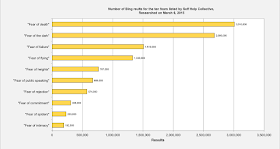Saturday, March 7, 2015
Is that Top Ten list from a real survey or just a glorified stack of web searches?
On March 6th my Google Alert on “public speaking” pointed to a long blog post by Brian Tracy titled 27 Useful Tips to Overcome Your Fear of Public Speaking. That is way too many tips for one post. Ten or twelve would be much better.
He included an infographic by Top Management Degrees from 2014 titled Speaking Up, with a section titled What Are We So Afraid Of? that has a list of ranks for ten most common fears. Public speaking ranked second. The list came from an article at Steve M. Nash’s Self Help Collective from 2009 (or perhaps before, based on a look at the Wayback Machine) titled Are These Your Top Ten Fears?
Those fears are:
1] Flying
2] Public speaking
3] Heights
4] The dark
5] Intimacy
6] Death
7] Failure
8] Rejection
9] Spiders
10] Commitment
Did they come from a poll or a survey? No, they just are:
“...based on the search engine keyword research used to help create SelfHelpCollective com; i.e. it's based on data taken from Google (and other popular search engines) and indicates the types of fear people are most looking for information on.”
(There also is a longer list in another article titled Are These the 33 Most Common Fears?)
In his 2008 book Click: What Millions of People Are Doing Online and Why It Matters on pages 103 and 104 Bill Tancer published another top ten list derived from web searches that doesn't include public speaking:
1] Flying
2] Heights
3] Clowns
4] Intimacy
5] Death
6] Rejection
7] People
8] Snakes
9] Success
10] Driving
The lists based on these desktop web search engine exercises aren’t very similar - they both have just 5 of those 10 items: Flying, Heights, Intimacy, Death, and Rejection. Also, unlike a real survey neither list provides results as numbers or percentages that would let you figure out whether items with adjacent rankings are nearly the same or very far apart.
Are either of these lists still useful? Would we get a similar list if we now looked at Google and Bing? I tried that exercise, and found the answer is not really.
The bar chart shown above lists the number of hits for Google searches on the same quoted phrases shown by Self Help Collective. (Click on it to see a larger, clearer view). The first three fears (death, the dark, and failure) have way more hits than the other seven. Also, the order is rather different with Death 1st rather than 6th, the Dark 2nd rather than 4th, Failure 3rd rather than 7th, Flying 4th rather than 1st, Heights 5th rather than 3rd, Rejection 6th rather than 8th, Public Speaking 7th rather than 2nd, Spiders 8th rather than 9th, Commitment 9th rather than 10th, and Intimacy at 10th rather than 4th.
Another bar chart lists the number of hits for Bing searches on the same quoted phrases shown by Self Help Collective. The first two (death and the dark) have way more hits than the other eight. Also, the order is rather different than the list at Self Help Collective, but the first five are exactly the same as on Google. Death is 1st rather than 6th, the Dark is 2nd rather than 4th, Failure is 3rd rather than 7th, Flying is 4th rather than 1st, Heights is 5th rather than 3rd. and Public Speaking 6th rather than 2nd. Rejection is 7th rather than 8th, Commitment 8th rather than 10th, Spiders the same at 9th, and Intimacy again at 10th rather than 4th.
The table shown above summarizes all the fear rankings. Are the rankings from 6 or 7 years ago still relevant? Probably not. So, why do people include them in their infographics?




No comments:
Post a Comment